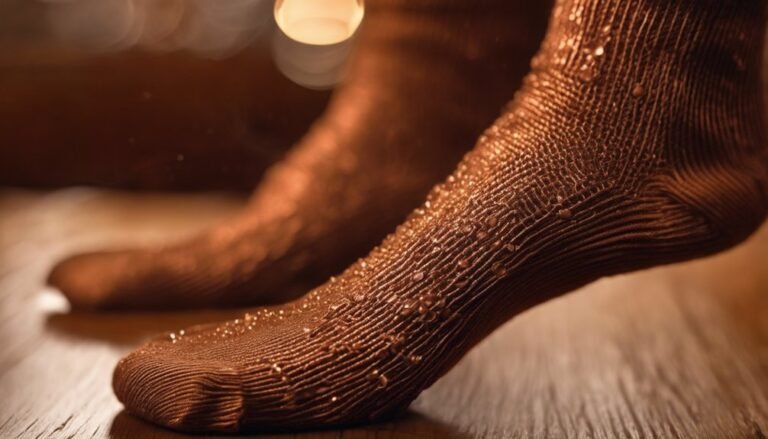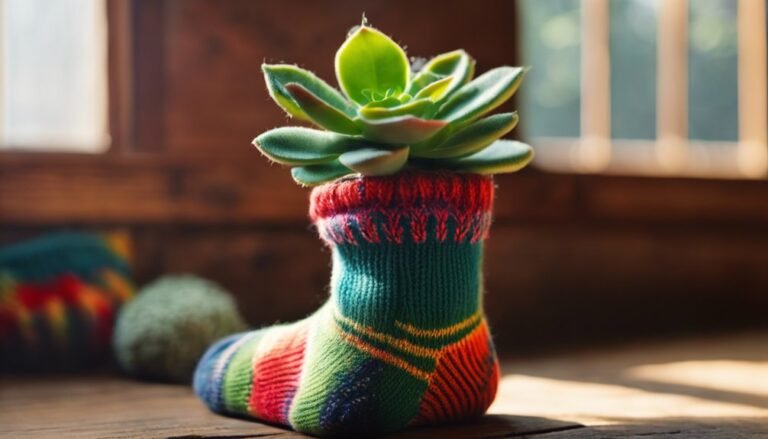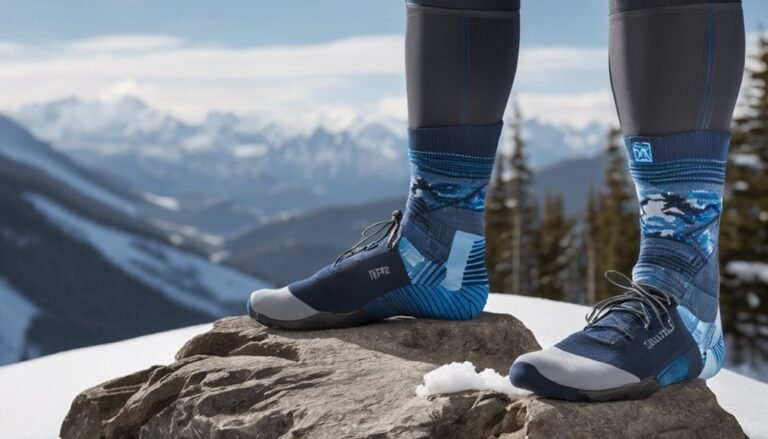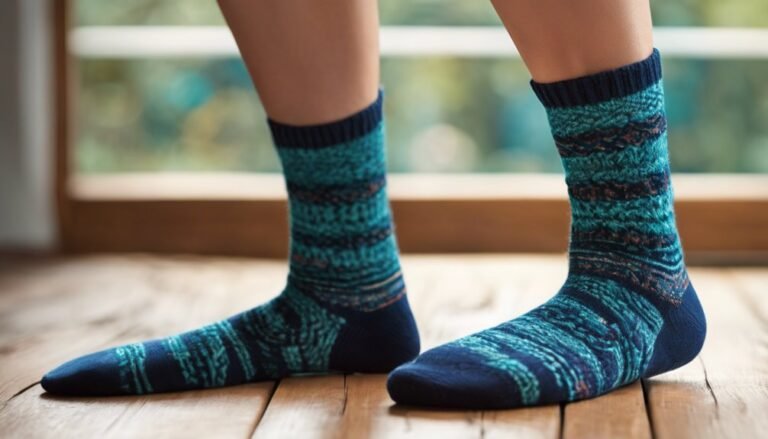The Best Socks for Keeping Feet Warm Without Overheating
To keep your feet warm without overheating, opt for socks made from moisture-wicking fabrics like merino wool or synthetic blends. These materials excel at regulating temperature and drawing moisture away from your skin. Look for medium thickness to balance insulation and breathability, and consider features like cushioning in high-impact areas to prevent blisters. Advanced options can also include compression for added warmth. There's much more to discover about selecting the right socks for winter activities.
Understanding the Importance of Moisture-Wicking Fabrics

When you're out in the cold, staying warm isn't just about thick layers; it's also about how well your socks manage moisture. Moisture-wicking fabrics are essential for effective moisture management, keeping your feet dry and comfortable. These advanced materials draw sweat away from your skin, preventing that clammy feeling that can sap your warmth and freedom of movement.
Look for socks made from synthetic fibers like polyester or nylon, which excel in moisture control, or merino wool, known for its natural moisture-wicking properties. With the right fabric technology, your socks can help regulate temperature, allowing your feet to breathe while staying insulated. Prioritizing moisture-wicking socks means embracing the great outdoors without the discomfort of damp feet. Choose wisely, and enjoy your adventures!
Top Materials for Warmth and Breathability
When it comes to keeping your feet warm, the choice between wool and synthetic fibers is essential. Wool offers natural insulation and excellent moisture-wicking properties, while synthetic materials provide durability and quick-drying capabilities. Understanding these differences can help you select the best socks for both warmth and breathability.
Wool vs. Synthetic Fibers
While both wool and synthetic fibers have their advantages, understanding how each material performs regarding warmth and breathability can help you make an informed choice for your socks. Wool benefits from its natural insulating properties, trapping heat while allowing excess moisture to escape, keeping your feet warm without overheating. It's also odor-resistant, making it an excellent option for prolonged wear. On the other hand, synthetic advantages lie in their lightweight, quick-drying nature, and durability. They often provide effective thermal regulation, ensuring your feet stay comfortable in various conditions. When choosing between the two, consider your activities and preferences—whether you prioritize the natural warmth of wool or the performance-oriented features of synthetic fibers, each option brings unique benefits to your sock drawer.
Moisture-Wicking Properties
To guarantee your feet stay warm and dry, it's vital to choose socks made from materials that excel in moisture-wicking properties. Look for fabrics like merino wool or specialized synthetics that effectively manage moisture. These materials pull sweat away from your skin, enhancing temperature regulation and preventing clamminess. This is important, especially during activities where your feet may sweat more than usual. By keeping your feet dry, you're not just ensuring comfort; you're also reducing the risk of blisters and cold feet. Always check for features such as breathable mesh zones or cushioning that support moisture management while maintaining warmth. With the right socks, you can enjoy the freedom of movement without worrying about overheating or dampness.
Features to Look for in Winter Socks
When choosing winter socks, you'll want to focus on material composition and how it impacts warmth and moisture management. Consider the thickness and insulation levels, as these factors directly affect your comfort in cold conditions. By understanding these features, you can select socks that will keep your feet warm and dry all winter long.
Material Composition Considerations
Choosing the right material for winter socks is essential for keeping your feet warm and comfortable, especially during cold weather. When considering sock materials, look for those with excellent insulation properties, like merino wool or synthetic blends. Merino wool offers natural moisture-wicking, keeping your feet dry and warm without overheating. Synthetic materials, such as polyester, can also provide effective insulation while being lightweight and quick-drying. Aim for socks that combine these materials to maximize warmth and breathability. Don't overlook features like cushioning and seamless designs, which enhance comfort and prevent irritation. By choosing the right combination of sock materials, you can guarantee your feet stay cozy, allowing you to embrace your outdoor adventures without the chill weighing you down.
Thickness and Insulation Levels
The thickness of winter socks plays a significant role in their insulation levels, directly impacting your overall warmth and comfort. When selecting socks, consider sock thickness as a key factor; thicker materials generally offer better insulation effectiveness, trapping more heat close to your skin. However, you don't want to overdo it—too thick can lead to overheating, especially during active pursuits. Look for socks that balance thickness with breathability, utilizing advanced materials that wick moisture away while maintaining warmth. Aim for a medium thickness that allows for freedom of movement without compromising insulation. Ultimately, the right combination will keep your feet cozy and dry, letting you enjoy your winter adventures without the discomfort of cold or sweaty feet.
Best Socks for Skiing and Snowboarding
How do you make sure your feet stay warm and comfortable while skiing or snowboarding? Choosing the right skiing socks or snowboarding socks is vital. Look for socks made from merino wool or synthetic blends, as these materials wick moisture away and provide excellent insulation without bulk. Opt for a mid-calf length to guarantee they stay securely in place and prevent cold air from creeping in. Pay attention to cushioning in high-impact areas like the toes and heels for added comfort. A snug fit is essential; loose socks can cause blisters, while overly tight ones restrict circulation. With the right pair, you can focus on carving down the slopes, enjoying your freedom in the great outdoors without worrying about cold feet.
Ideal Choices for Winter Hiking
Skiing and snowboarding require specialized socks to keep your feet warm, but winter hiking demands equally careful sock selection. To guarantee comfort and warmth, consider these ideal choices that utilize effective insulation techniques and layering strategies:
- Merino Wool Socks: Excellent moisture-wicking and thermal regulation properties.
- Synthetic Blends: Quick-drying, they offer a balance of warmth and breathability.
- Thick Padded Socks: Provide cushioning and reduce friction, preventing blisters on long hikes.
- Compression Socks: Enhance blood circulation, keeping your feet warmer and more energized.
Cozy Socks for Lounging at Home

When you're ready to unwind after a long day, slipping into a pair of cozy socks can make all the difference in your comfort level. Look for socks made from cozy materials like merino wool, fleece, or bamboo, as these fabrics not only retain warmth but also wick moisture away from your feet. When choosing lounging styles, opt for thicker, plush options that envelop your feet in softness without causing overheating. Consider socks with non-slip grips for added stability while moving around your home. Whether you're curling up with a book or watching a movie, the right cozy socks can enhance your relaxation experience, giving you that much-desired freedom to kick back and enjoy your downtime.
Performance Socks for Active Winter Sports
For those who thrive on the adrenaline of winter sports, the right performance socks can greatly impact your experience on the slopes or trails. With advanced sock technology, you can enjoy ideal thermal performance without overheating. Here are key features to look for:
- Moisture-Wicking Fabric: Keeps sweat away, maintaining dryness.
- Strategic Padding: Provides comfort and support in high-impact areas.
- Compression Zones: Enhances circulation and reduces fatigue.
- Temperature Regulation: Balances warmth and breathability for varying conditions.
These socks are designed to move with you, ensuring your feet stay warm and comfortable while you conquer the winter wilderness. Choose wisely, and let your feet feel the freedom of the great outdoors!
Sustainable Options for Eco-Conscious Shoppers
As consumers become more environmentally conscious, the demand for sustainable sock options has surged, offering solutions that keep your feet warm without compromising the planet. By choosing socks made from sustainable materials, you can enjoy cozy comfort while supporting eco-friendly brands committed to minimizing their environmental impact.
| Brand | Sustainable Materials | Features |
|---|---|---|
| EcoSock Co. | Organic cotton, bamboo | Moisture-wicking, soft |
| GreenFootwear | Recycled polyester | Durable, breathable |
| NatureKnits | Merino wool, hemp | Insulating, temperature-regulating |
Investing in these eco-conscious choices not only enhances your comfort but also contributes to a healthier planet, allowing you to express your values with every step you take.
Care Tips to Extend the Life of Your Winter Socks

To guarantee your winter socks last through many chilly seasons, it's essential to adopt proper care techniques that maintain their warmth and integrity. Here are some important tips:
- Washing Techniques: Always wash your socks in cold water and on a gentle cycle to preserve fibers.
- Drying: Avoid the dryer! Air-dry your socks by laying them flat to prevent shrinkage and wear.
- Socks Storage: Store your socks in a cool, dry place. Avoid cramming them into tight spaces, which can distort their shape.
- Rotate Usage: Give your socks a break by rotating pairs, allowing them to recover their shape and elasticity.
Frequently Asked Questions
How Often Should I Wash My Winter Socks?
You should wash your winter socks based on their material—wool, for example, can last longer between washes. Generally, aim for every 3-5 wears to maintain hygiene and extend their lifespan without compromising comfort.
Can I Wear Cotton Socks in Winter?
You can wear cotton socks in winter, but they absorb moisture, which can leave your feet cold. Consider winter sock alternatives like wool or synthetic blends for better insulation and moisture management, ensuring warmth without discomfort.
What Sock Thickness Is Best for Warmth?
You might think thicker socks mean warmer feet, right? Actually, the best warmth comes from materials like merino wool that provide thermal insulation without bulk. Opt for medium thickness to balance comfort and efficiency!
Are Compression Socks Suitable for Cold Weather?
Compression socks can be suitable for cold weather, offering benefits like improved circulation. Opt for materials like merino wool or thermal blends to keep your feet warm without sacrificing comfort or freedom of movement.
How Do I Choose the Right Sock Size?
To choose the right sock size, you'll wanna measure your foot length in inches or centimeters. Compare that measurement against the sizing chart provided by the manufacturer. Comfort's key, so don't skip this step!







